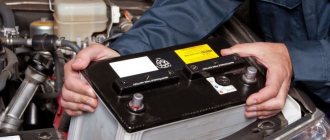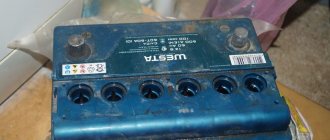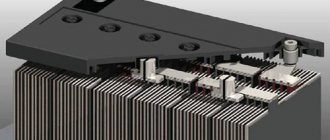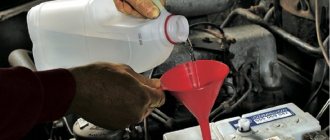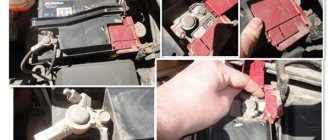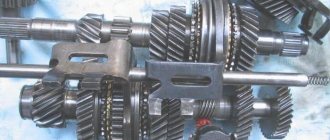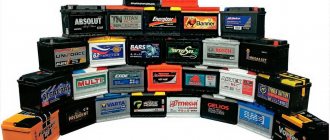In modern cars, the role of power supplies is increasing. Engineers are increasing the number of consumers in the on-board network, so energy costs are increasing. If the car engine is not running, current is supplied to consumers from the battery. The quality of engine starting also depends on its condition.
What is an electrolyte
Most batteries installed in cars are liquid lead-acid power sources. They are divided into serviced and unserviced types. In fact, this is not a single container with electrodes, but several containers (cans) connected in series.
Inside each can there are lead electrodes separated by non-conducting separators. The metal is located in a liquid electrolytic medium consisting of a special acid solution.
The electrolyte in a car battery is a colorless solution of sulfuric acid and distilled water with an approximate density of 1.23–1.25 g/ml.
Thanks to the liquid medium, electrochemical processes occur in batteries, leading to the generation of electricity. The degree of battery charge is influenced by various factors, including the density of the solution, ambient temperature, contamination of the plates (degree of sulfation) and the level of liquid in the jars.
Battery recovery
To pour the prepared solution inside, you need to unscrew the plug and put it on the fitting of the ventilation hole. The plug must be firmly placed on the corresponding hole. Next, the product is poured inside. The plug is screwed in and charging is performed.
Some drivers may be wondering how to restore their battery. The methods for carrying out this process are reduced to charging at low current. The procedure takes a long time, after which the density may increase slightly. Sulfuric acid can be poured inside only when the plates are in working condition.
By considering what electrolyte level should be in the battery, as well as expert recommendations, you can restore the performance properties of the device being serviced.
Automotive battery technology has advanced significantly over the past couple of decades. If previously it was necessary to constantly check the electrolyte level in the battery, modern models require much less attention to themselves. Manufacturers call these batteries maintenance-free, stating that they do not require constant monitoring of the electrolyte level. But the word maintenance-free can mislead the car enthusiast. After all, these batteries still require maintenance, which we will discuss in this article.
Why is electrolytic fluid needed in a battery?
Without conductive fluid, a lead-acid battery in a car will not work. The electrolyte ensures the movement of ions between the electrodes (positive anode and negative cathode). At the positive contact, water molecules split into two hydrogen ions, an oxygen molecule, and a pair of electrons is released. Near the negative electrode, a pair of free electrons meets two hydrogen ions to form a hydrogen molecule. These processes occur when energy is released from the battery to consumers, and during charging the reverse processes occur.
How much electrolyte should be in the battery
Let's figure out what the optimal level of high-quality electrolyte should be in a car battery. The cases of many battery models with liquid inside are made in such a way that the amount of filling of the internal space can be seen from the outside. On the outside of the case of such batteries there may be marks indicating the minimum (min) and maximum (max) values, which makes it easier to monitor the current condition.
It is recommended to maintain the electrolyte level in a working car battery closer to the maximum permissible value.
A fall below the min level can lead to immediate irreparable damage to the battery. In serviced models with regular use, experts recommend monitoring the condition of the fluid approximately every two to three weeks. Particular attention should be paid to the condition in the summer, during hot periods, when the likelihood of evaporation increases and the amount of electrolyte in the jars will decrease.
Manufacturers have established the dependence of the volume of an aqueous solution of sulfuric acid on the battery capacity. The higher the Amp Hours, the more fluid needed. Let's find out how much electrolyte is in your battery:
- 55 Ah – 2.5 l;
- 60 Ah – up to 3 l;
- 75 Ah – 3.7–4 l;
- 90 Ah – up to 4.8 l;
- 190 Ah – from 10 l.
Some batteries are sold dry-charged, so you need to add the solution yourself. Such a dependence will help you figure out how many liters will be the norm.
What is a maintenance free battery?
The concept of a maintenance-free battery has come into use since the advent of Ca/Ca car batteries. In such models, positive and negative electrode arrays are made from an alloy of lead and calcium. The so-called serviced models that were produced before had grilles made of an alloy of lead and antimony. Old car batteries had a high antimony content and very high water consumption. Now they are no longer produced, and they have been replaced by models with a lower antimony content. They are also called low-antimony. The antimony content in the plates is less than 6 percent. In them, monitoring the electrolyte level must be periodic, since distilled water is constantly leaving it. Why? To do this, you need to consider the processes occurring in the battery.
When the battery is discharged, lead dioxide is reduced inside the car battery at the anode with sulfuric acid. At the same time, lead oxidation occurs at the cathode. When charging a battery, the process goes in the opposite direction. Antimony was added to lead plates in order to improve their strength characteristics. It is not possible to use electrodes made of pure lead due to its low strength. But the addition of antimony also brings a problem. Antimony acts as a catalyst for the hydrolysis of water from the electrolyte. Hydrolysis is the decomposition of water into hydrogen and oxygen under the influence of electric current. Outwardly it looks like boiling. That is why such an expression as “boiling away” of water from an electrolyte arose.
To solve this problem, manufacturers began to add calcium to electrode grids. This solution turned out to be very successful in terms of reducing water consumption.
With the advent of calcium-type car batteries, the concept of maintenance-free batteries appeared. And the lack of need for maintenance only concerns adding water to the battery.
Models without openings for access to banks began to appear in the product lines of battery manufacturers. To check the state of charge of the battery on such batteries you can often find a hydrometer or “peephole”. The hydrometer is designed to monitor the battery charge level. In the images below you can see a maintenance-free and a maintenance-free battery.
We also recommend reading the article about battery labeling.
Hybrid car battery
It is worth noting another category of maintenance-free batteries – gel batteries. In gel batteries, the electrolyte is in a bound state. This may be an impregnation of fiberglass or a gel-like state. In most cases, such models are made in maintenance-free housings and do not require topping up water. Although in some cases distilled water is added to AGM batteries. For example, when restoring gel batteries.
How to check the level
Monitoring the condition of a car battery does not require expensive equipment. It is also not necessary to go to a car service center, because all operations can be carried out in a garage with minimal tools.
Checking the current level of electrolyte solution in a car battery is carried out using the following algorithm:
- before determining the level of acid solution in the battery banks, it is necessary to let the battery sit for a couple of hours, and then, removing the terminals, remove the charged power source from the engine compartment;
- we determine from the outside by the marks on the body (min/max) the degree of liquid filling;
- to check the electrolyte level in the battery being serviced, you will need a transparent glass tube, open at both ends and with an internal diameter of 3–5 mm;
- unscrew the plugs from the battery cans;
- lower the tube into one of the open containers until it stops on the lead plates;
- press the upper open part tightly with your finger and carefully lift the tube;
- We take an approximate level measurement and return the liquid to the jar;
- We perform the operation with the remaining containers, recording the results.
The optimal value is 10–12 mm above the level of the plates. If there is a deviation from the nominal value, we recommend eliminating it by adding distillate.
Preparation of the solution
Having determined what level of electrolyte should be in the battery, you can take measures to restore the required value of the solution. If you need to add it to the container, you need to prepare the appropriate material.
The solution can be purchased or prepared independently. To create an electrolyte of the correct consistency, you need to prepare 1 liter of distilled water (sold in a pharmacy). You will also need 0.36 liters of sulfuric acid. It is prohibited to use tap water for such purposes.
All components are poured into a plastic container. Everything needs to be mixed well. After this, the solution is closed with a tight lid and left for a day. Then you can use the prepared product.
High and low level danger
If there is little or too much electrolyte in your battery, this will have negative consequences on the operation of this power source in the car. This fact is relevant for a battery of any size.
If the optimal volume is exceeded during boiling, there is a risk of splashing of aggressive chemical liquid. Also, in some cases, gas accumulated under high pressure can cause a battery explosion.
Low electrolyte levels also cause problems. Most often, in such circumstances, sulfation of the plates and their subsequent destruction are provoked. An additional negative is a significant decrease in the capacity of the power source below the limits allowed by the manufacturer.
Factors affecting battery life
To understand what you should focus on when performing preventive work, you should know about the processes and factors that negatively affect the device. These include:
Average state of charge
Ideally, the battery in the car should always be fully charged, that is, the capacity lost during idle time should be replenished from the generator while the engine is running. However, with a large number of consumers (headlights, radio, air conditioning, TV), as well as with frequent engine starts, the generator simply does not have time to replenish the lost charge. In addition, low temperatures also contribute to faster loss of capacity (more on this below). As a result of these factors, the battery is constantly in an undercharged state, and the lower the average state of charge, the less the battery “lives”. It is for this reason that it is necessary to periodically recharge the battery using an AC charger, or, as it is popularly called, “charging”.
Temperature at which the battery is operated
Ambient temperature greatly affects the technical characteristics of the battery. For example, the battery produces its nominal capacity only at temperatures above twenty degrees. Its decrease by one degree leads to a drop in capacity by 1 Ah. This leads to difficulties when starting the engine in winter. In addition, if the battery is completely discharged due to low temperature, the electrolyte in it may freeze, which will result in failure of the device.
On the other hand, high temperature leads to boiling of the electrolyte, due to which water begins to quickly evaporate from the composition. And this entails a drop in the liquid level, which subsequently results in oxidation of the plates. To avoid this, it is necessary to periodically check the electrolyte level.
On-board network status
The operation of the battery is also affected by the condition of the vehicle’s on-board network, namely: the contact connection of the modules, the quality of the wiring, and the number of consumers. But the most important elements are the generator and voltage regulator. If they work poorly, the battery will have to be changed very soon. At high voltage supplied to the battery, the electrolyte will constantly boil, and at low voltage, the device will discharge. The negative consequences of these factors were written above.
What to do if the electrolyte solution level is low or high
The motorist will be able to restore the volume of the acid solution independently, subject to safety precautions and the availability of materials and tools. Let us next consider whether it is possible to add purchased electrolyte to a car battery yourself. Let's determine how to properly restore the balance of liquid in jars.
For topping up, motorists can use both ready-made electrolyte and distillate. However, most often the second option is necessary, since during operation and charging periods, water mostly boils away, and the acid concentration increases. Adding the electrolyte directly is relevant for those cases when it splashed out of the common container or the solution was lost through cracks or microcracks.
Having identified an excess of liquid level, it is necessary to select the excess. For this operation, a rubber bulb with a hard tip inserted, for example from a glass tube, is suitable. After taking the liquid, we repeat the measurement and restore the balance.
It is strictly unacceptable to turn the battery over to drain excess acid solution, as there is a risk of destruction of the fragile lead plates. This applies to batteries with a long service life.
Battery maintenance and diagnostic process
So, what does the process of maintenance (prevention) and diagnostics of batteries include?
- Any device must be serviced in comfortable conditions. For maintenance, the battery must be removed from the vehicle and taken to a suitable room. If this happens in winter, you need to give the battery time to warm up to room temperature.
- Cleaning from dirt, oil drips, and any foreign contaminants.
- Checking the level and density of the electrolyte using a hydrometer (if there are plugs for filling the electrolyte).
- Checking the battery charge level using a load plug.
- Charging the battery.
- Checking the condition of current terminals.
So you've removed the battery from your car and are trying to bring it home. Batteries come with or without handles. In the first case, carrying does not cause any problems. In the second case, you need to carry it carefully, without leaning it against your clothes; it is advisable to use some kind of carrying device.
Even on a seemingly dry body, traces of electrolyte always remain, and after a few days, burnt spots may appear on clothing.
The battery must be allowed to settle until it reaches room temperature, after which it must be thoroughly cleaned of all contaminants.
If your battery is maintenance-free, i.e. does not have filler plugs - the battery can be washed under a gentle stream of water using a brush. Before washing, you can treat the battery case with some concentrated detergent to dissolve old and oily contaminants.
Serviced batteries are cleaned with a dampened rag or sponge, avoiding any liquid getting into the filler plugs.
In both cases, the battery case is wiped dry.
How to wash the battery is described in detail in the video:
IMPORTANT. The batteries being serviced must not be tilted at an angle of more than 30° to avoid electrolyte leakage through the filler plugs.
The battery has settled and now you need to measure the voltage at the terminals using a multimeter.
You can estimate the degree of battery discharge using a special table
The next step is to check the level and density of the electrolyte.
Using a screwdriver with a wide blade or a two-ruble coin, you need to unscrew and remove the plugs from the filler holes.
Now you need to check the level and density of the electrolyte in each battery bank.
In order not to repeat ourselves, this stage is described in great detail in the article on hydrometers.
If the level and density are normal, this is good. If the parameters deviate from generally accepted standards - the electrolyte level should be within 10-15 mm above the upper cut of the plates, and the density should be in the range of 1.27-1.29 g/cm3, then they must be brought to normal.
In warm regions, the normal density value is considered to be 1.26 g/cm3, and in regions of the Far North at very low temperatures the density is increased to 1.30 g/cm3.
To increase the level, you need to add only distilled water, and to increase the density, charge the battery.
Measuring battery voltage with a load plug.
After charging the battery, you need to check it using a load plug.
For an ordinary user, it is enough to have the simplest and most inexpensive option - Orion NV-01 at a price of 600 rubles. You will use it at most five times during the year, and there is no point in buying expensive and sophisticated ones.
Using a load fork, two measurements are made - open circuit voltage and voltage under load.
It is not recommended to take measurements on a cold battery when it has just been removed from the car or from charging. The battery must stand for 10-12 hours to come to a state of rest.
How to take measurements is described in detail in the article “Load forks for battery testing.”
The open circuit voltage of a fully charged battery should be within 12.6÷12.7 V. If the open circuit voltage is below these values, this indicates that the battery is discharged or undercharged.
Then we check the voltage value under load for 5 seconds. The load fork simulates a load that is 2 times the nominal capacity of the battery. Those. if the battery has a capacity of 50 A/h, use a 100 A load plug.
If, when measured under load, the voltage is below 10 V, then this means your battery has serious problems.
After all the operations performed, the battery must be charged, regardless of what voltage readings were obtained during the measurements.
After the charging process is completed, after 10-12 hours it is necessary to re-measure the voltage.
At the final stage of maintenance, it is necessary to check the condition of the current leads and terminals on the live wires.
The process of servicing battery current leads and terminals is described in detail in the article “Car battery terminals”.
This is not directly related to the battery maintenance process, but I would like to say a few words on the topic of using terminal lubrication.
There is a misconception that you first need to lubricate down conductors and terminals, and then install them.
IMPORTANT. First, the down conductors and terminals are cleaned using a scraper, quickly connected to each other, tightened with bolts, and only then a thin layer of lubricant can be applied.
